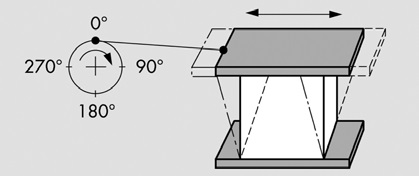Oscillatory measurements are often used for the rheological characterization of different materials. They are particularly useful for characterizing the structures of viscoelastic samples.
How Do I Use Oscillatory Tests and Which Parameters Do I Measure?
In oscillatory tests the measuring system moves backwards and forwards at a set frequency and amplitude. The advantage of performing the test in such a way is that small strains are applied onto the sample allowing stiff and solid samples to be measured.
A mechanical model for an oscillatory measurement is illustrated in Fig. 1: The lower plate is static whereas the upper plate moves back and forth driven by a wheel with an eccentrically mounted push rod.

Figure 1. Two-plate model for oscillatory tests.
At 90° and 270° deflection the upper plate reaches its maximum amplitude. The torque required to move the upper plate divided by the area of the plate results in the applied shear stress τ. The strain γ can be calculated from the deflection with respect to the gap size.
Oscillatory tests can be measured with two different types of test settings.
- In a Controlled Shear Stress (CSS) test a torque is applied to reach the given shear stress and the resulting deflection or strain is measured.
- In a Controlled Shear Deformation test (CSD) the given strain is set by the control of the deflection angle and the required shear stress is measured.
Most oscillatory tests are performed in controlled strain mode. The given deformation and the measured time-delayed shear stress response are used to calculate the storage modulus G’ and loss modulus G’’.
The storage modulus G' is a measure of the deformation energy stored in the system. It reflects the solid character (the elastic part) of the sample. The loss modulus G'' is a measure of the lost deformation energy and therefore characterizes the liquid part (the viscous part) of the sample. These two parameters are most frequently displayed in diagrams of oscillatory tests.

 Want to know more? Click here to read the full article.
Want to know more? Click here to read the full article.
.jpg)
This information has been sourced, reviewed and adapted from materials provided by Anton Paar GmbH.
For more information on this source, please visit Anton Paar GmbH.